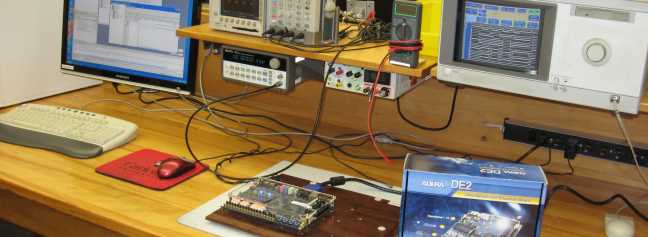 |
| Testing an integrated sensor circuit board |
Sensors are known in popular terminology as objects or devices whose purpose is to detect changes or events in the surrounding environment and then produce a signal that measures or indicate the change. These devices are prevalent and pervasive in day-to-day life, from the thermometers that measure the change in temperature to devices that measure speed, acceleration, intensity of ambient light, humidity, pressure, acidity, magnetic and electrical fields and so on. More recently, sophisticated classes of chemical and biosensors continue to be developed. These sensors designed to detect and measure the presence of specific chemical compounds and materials of biological nature.
Research in the field of sensors is motivated by numerous applications that have substantial social and economic impact. Examples of such applications include:
- Improving quality of life through the use of classes of sensors that detect harmful environmental conditions,
- Contributions to healthcare and wellness through the use of biomedical sensors and vital signs monitors,
- Improving the efficiency of industrial and manufacturing processes and enhancing the quality of industrial and agricultural products,
- Enhancing the safety and security of all citizens through automated early alert systems,
- Assisting and enabling people with special needs to lead normal lives.
Many of the common applications involve the use of a single sensor device whose output is displayed in some visual or printed form. However, many existing and emerging practical applications require the use of several identical or dissimilar types of sensors in order produce a meaningful outcome that is specific to the application. This takes place, for example, when the detection of specific characteristics must be done over a large geographic area, such as in environmental or agricultural applications. In other cases, the output of sensors of a single type is not sufficient to identify with accuracy the object being detected. In such cases, the output of different types of sensors may be combined using analytical approaches in order to achieve the target objective. Examples of such applications that require the deployment of heterogeneous groups of sensors include the investigation of crime scenes or search and rescue missions in bad climate conditions.
Combining a group of sensors to measure or achieve a specific objective requires the development of what we call an “Integrated Sensors Platform”. The platform combines a group of sensors of similar or dissimilar types with a control mechanism and with a data processing system that collects and analyses the output of the sensors in real-time, to produce accurate and timely detection. The platform can have different form factors and the flow of information among the sensors, the controller and with the data processing system can take place through wired connections or over wireless channels.
This site has two main objectives. The first is to disseminate information about on-going research activities in the field of sensors that take place within the Faculty of Engineering and Design at Carleton University, and their applications.
The second main objective is to promote cooperative and collaborative research work at the international level with academic and research institutions that have similar interests.
Research taking place within CRISP is generally concerned with the following aspects:
- Development and fabrication of new classes of sensors (micro-scale),
- Development of sensors that are environmentally safe,
- Enhancing the sensitivity of existing sensors,
- Development of integrated sensors platforms with small form factors and low power,
- Wireless sensor networks,
- Processing of large data sets generated from sensor networks and platforms,
- Applications involving integrated sensors platforms,
- Wearable devices.

